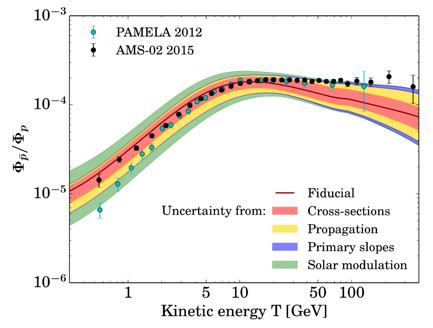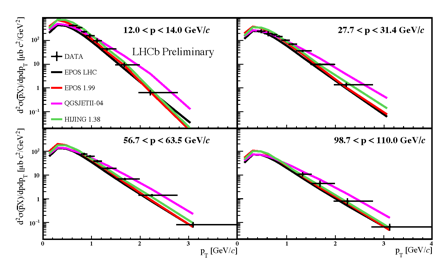Can cosmic-ray antiprotons unveil dark matter collisions?
This week, at the 52nd Rencontres de Moriond EW in La Thuile Italy, LHCb presented results of an analysis which may have significant consequences for the search for “dark matter” in the universe. The measurement is of antiproton production in proton-helium (p-He) collisions. Although the LHC collides protons with protons, the LHCb experiment has the unique ability to inject gas, for example helium, into the interaction region and therefore study processes that would otherwise be inaccessible, such as here the production of antiprotons from p-He interactions. The forward geometry and particle identification capabilities of the LHCb detector are well suited to provide good reconstruction for antiprotons down to the low transverse momentum region where most of the production is expected. This gas-injection system was originally designed to help LHCb measure the brightness of the accelerator’s beams, but is now being used for dedicated physics measurements.
This result is very important for interpreting searches for dark matter in the Universe. Dark matter is a hypothetical entity of unknown nature whose existence would explain a number of otherwise puzzling astronomical and cosmological observations. The name refers to the fact that it does not interact with electromagnetic radiation (like light). Although dark matter has not been directly observed, its existence and properties are inferred from its gravitational effects such as the motion of visible matter around galactic centres and precise measurements of temperature fluctuations in the cosmic microwave background. An interesting possibility is that dark matter is composed of some kind of stable elementary particles whose existence is proposed in different extensions of the Standard Model of particle physics. In such a case these dark matter particles could collide and produce ordinary particles, in particular antiprotons. However antiprotons can also be produced in standard processes through collisions of cosmic rays with the interstellar medium, of which helium is a significant component. Therefore a potential signature of dark matter is the observation in space of a higher ratio of antiprotons to protons than would be expected from standard processes. Excitingly, this tendency is hinted at in measurements from the PAMELA and AMS experiments, as seen in the image that shows the measured p/p ratio against energy. Also shown in the image is the prediction (‘Fiducial’) and, as coloured bands, the uncertainties on this prediction, which come from the limited knowledge of several of the ingredients in the calculation. Although the data points lie above the prediction, the current uncertainties are large enough to almost accommodate the discrepancy, thereby preventing an unambiguous interpretation. The largest uncertainty is associated with the knowledge of the cross-sections, in particular that of p-He collisions. This is where LHCb enters the game.
LHCb has performed the first measurement of the antiproton cross-section in p-He collisions in an energy range that is critical for the interpretation of the PAMELA/AMS-02 studies. A precision of around 10% is attained, which is significantly more precise than the assumptions that have entered the cosmic ray calculations. In the image, the result is compared with the most popular models used in cosmic rays physics. The spread among model predictions indicate the large uncertainty on the process prior to this measurement. It will be very interesting to see how this measurement affects the prediction of the p/p ratio in space, and from this, what are the consequences in the searches for dark matter.
More details can be found in the LHCb presentation and soon in the LHCb conference note. Read more in the CERN update for the public both in English and in French and also in the CERN Courier article.


